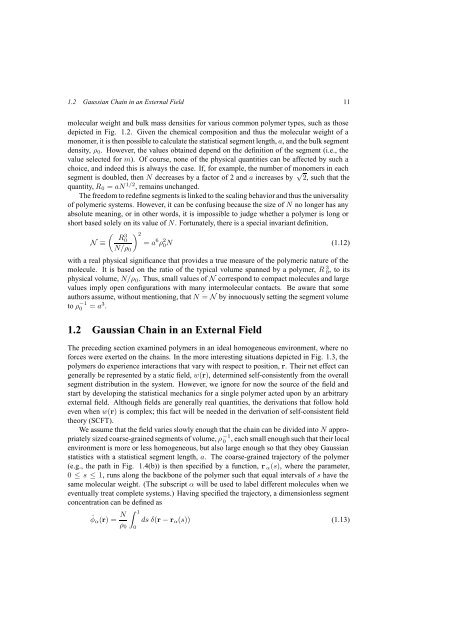Self-Consistent Field Theory and Its Applications by M. W. Matsen
Self-Consistent Field Theory and Its Applications by M. W. Matsen
Self-Consistent Field Theory and Its Applications by M. W. Matsen
You also want an ePaper? Increase the reach of your titles
YUMPU automatically turns print PDFs into web optimized ePapers that Google loves.
1.2 Gaussian Chain in an External <strong>Field</strong> 11<br />
molecular weight <strong>and</strong> bulk mass densities for various common polymer types, such as those<br />
depicted in Fig. 1.2. Given the chemical composition <strong>and</strong> thus the molecular weight of a<br />
monomer, it is then possible to calculate the statistical segment length, a, <strong>and</strong> the bulk segment<br />
density, ρ 0 . However, the values obtained depend on the definition of the segment (i.e., the<br />
value selected for m). Of course, none of the physical quantities can be affected <strong>by</strong> such a<br />
choice, <strong>and</strong> indeed this is always the case. If, for example, the number of monomers in each<br />
segment is doubled, then N decreases <strong>by</strong> a factor of 2 <strong>and</strong> a increases <strong>by</strong> √ 2, such that the<br />
quantity, R 0 = aN 1/2 , remains unchanged.<br />
The freedom to redefine segments is linked to the scaling behavior <strong>and</strong> thus the universality<br />
of polymeric systems. However, it can be confusing because the size of N no longer has any<br />
absolute meaning, or in other words, it is impossible to judge whether a polymer is long or<br />
short based solely on its value of N. Fortunately, there is a special invariant definition,<br />
( ) R<br />
3 2<br />
N≡ 0<br />
= a 6 ρ 2 0<br />
N/ρ N (1.12)<br />
0<br />
with a real physical significance that provides a true measure of the polymeric nature of the<br />
molecule. It is based on the ratio of the typical volume spanned <strong>by</strong> a polymer, R 0 3 , to its<br />
physical volume, N/ρ 0 . Thus, small values of N correspond to compact molecules <strong>and</strong> large<br />
values imply open configurations with many intermolecular contacts. Be aware that some<br />
authors assume, without mentioning, that N = N <strong>by</strong> innocuously setting the segment volume<br />
to ρ −1<br />
0 = a 3 .<br />
1.2 Gaussian Chain in an External <strong>Field</strong><br />
, each small enough such that their local<br />
environment is more or less homogeneous, but also large enough so that they obey Gaussian<br />
statistics with a statistical segment length, a. The coarse-grained trajectory of the polymer<br />
(e.g., the path in Fig. 1.4(b)) is then specified <strong>by</strong> a function, r α (s), where the parameter,<br />
0 ≤ s ≤ 1, runs along the backbone of the polymer such that equal intervals of s have the<br />
same molecular weight. (The subscript α will be used to label different molecules when we<br />
eventually treat complete systems.) Having specified the trajectory, a dimensionless segment<br />
concentration can be defined as<br />
The preceding section examined polymers in an ideal homogeneous environment, where no<br />
forces were exerted on the chains. In the more interesting situations depicted in Fig. 1.3, the<br />
polymers do experience interactions that vary with respect to position, r. Their net effect can<br />
generally be represented <strong>by</strong> a static field, w(r), determined self-consistently from the overall<br />
segment distribution in the system. However, we ignore for now the source of the field <strong>and</strong><br />
start <strong>by</strong> developing the statistical mechanics for a single polymer acted upon <strong>by</strong> an arbitrary<br />
external field. Although fields are generally real quantities, the derivations that follow hold<br />
even when w(r) is complex; this fact will be needed in the derivation of self-consistent field<br />
theory (SCFT).<br />
We assume that the field varies slowly enough that the chain can be divided into N appropriately<br />
sized coarse-grained segments of volume, ρ −1<br />
0<br />
ˆφ α (r) = N ∫ 1<br />
ds δ(r − r α (s)) (1.13)<br />
ρ 0<br />
0
















